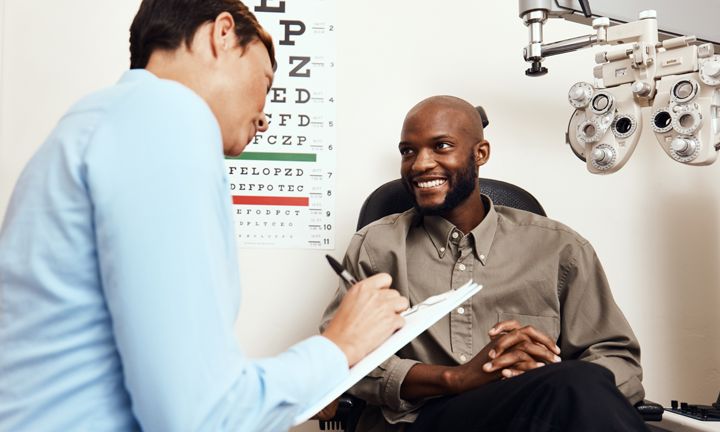Thanksgiving is right around the corner and this year there is no need to let the poetic overindulgence get in the way of your eye health. Believe it or not, many of your favorite Thanksgiving foods, from the green beans, all the way down to the pumpkin pie, contain healthy levels of vitamins and micronutrients that actually boost your vision and overall eye health. So much so, you may find yourself saying, “Why yes, I will have a second piece, please,” a couple times over the Thanksgiving holiday.
Vitamins and Micronutrients That May Help Protect Your Eyesight
Let's talk about foods containing dietary antioxidant vitamins and minerals, foods containing omega-3 fatty acids, and two naturally occurring carotenoids: lutein and zeaxanthin and how each of these vitamins and micronutrients may help support your eye health.
Dietary Antioxidant Vitamins and Minerals
Light entering your eye transmits images to your retinas that make it possible for you to see. That same sunlight creates an environment of oxidative stress, which leads to the release of free radicals. In the absence of vitamins A, C, and E, and the mineral zinc, free radicals can damage the tissues at the back of the eye. Over time, this cumulative damage can affect the macula, the part of the retina responsible for central vision, and lead to age-related macular degeneration (AMD).
Foods containing dietary antioxidant vitamins and minerals combine with free radicals in the eye to consistently eliminate their damaging effects. Here are some of the foods that can help protect your eyesight:
-
Foods with vitamin A: Carrots, squash, sweet potatoes, broccoli, cantaloupes, leafy greens, apricots, mangos, red peppers, egg yolks
-
Foods with vitamin C: Oranges, lemons, limes, grapefruits, broccoli, Brussels sprouts, potatoes, sweet potatoes, red peppers, strawberries, kiwis
-
Foods with vitamin E: Pumpkins, avocados, mangos, asparagus, red peppers, spinach, collard greens, peanut butter/peanuts, almonds, sunflower seeds, wheat germ
-
Foods with Zinc: Oysters, chicken, whole grains, chickpeas and other beans, nuts, yogurt, crab, lobster
Omega-3 Fatty Acids
Foods containing omega-3 fatty acids can help improve your vision and overall eye health. Within many foods we eat, there are substances that can cause inflammation throughout the body. This inflammation can be a risk factor for several chronic illnesses and conditions, including age-related macular degeneration (AMD) in your eyes. Therefore, seeking out dietary choices that avoid these substances, or even by including foods with anti-inflammatory substances, may help decrease your chances of developing eye related diseases. Omega-3 fatty acids not only have a chemical structure that has antioxidative properties, but they may also reduce inflammation in the eyes.
-
Foods with omega 3: Walnuts, chia seeds, flaxseed, sardines, herring, salmon, tuna, flaxseed oil, soybean oil
Lutein and Zeaxanthin
Two naturally occurring carotenoids in many vegetables and other plants, lutein and zeaxanthin prevent damage to plants from overexposure to sunlight, by absorbing excessive energy. These two micronutrients also have antioxidant properties, appearing in high concentrations in your retinas and quickly absorbing any free radicals formed from radiative sunlight. It has been shown that lutein and zeaxanthin, among other things, can help prevent AMD, by blocking the damaging blue light from reaching the sensitive lower layers of the retinas.
-
Foods with lutein and zeaxanthin: Kale, spinach, collard greens, peas, squash, egg yolks, beets, tomatoes, corn, nuts, broccoli, Brussels sprouts, romaine lettuce, oranges
Packing Your Thanksgiving Meal With Eye Health Friendly Foods
You have probably already noticed, but a lot of the foods listed above already make noteworthy appearances on your Thanksgiving Day table. So, in a certain sense, you don’t have your work cut out for you—well, other than the actual food you made. Even still, if you’re interested in increasing the vision-enhancing ingredients in your Thanksgiving meal, try out these following ideas.
Just Add Nuts
Adding nuts and seeds to any number of traditional dishes is an easy way to help the eye health of your family. One way to incorporate nuts into your Thanksgiving meal is to consider adding nuts in your ambrosia salad. Simply add a ¼ cup of chia seeds and half a cup of chopped walnuts to the mixture before chilling it. Both will provide the salad with a satisfying texture while helping to bind all the ingredients. You can also add sliced almonds to your turkey’s stuffing, dress your green salad with flaxseed oil, or simply stick to your classic pecan pie recipe.
Add Vitamin C
Looking to load up on vitamin C, but don’t want to miss out on a little holiday fun? There are hundreds of autumn and winter whiskey punch, sangria, and mulled wine recipes available online. Not only are they bound to be a hit, but they are oftentimes very easy to prepare and filled with lots of vitamin C-rich citrus fruits. Great for any Thanksgiving celebration.
Make a Big Salad
Not everyone likes to include a typical green salad in their turkey day, but it’s really a very simple way to sneak in a full sleuth of foods good for eye health. Use a medley of greens, which are important to eye health, and then throw in some beans, corn, and beets, and finally, concoct your dressing from a healthy vegetable oil and a fresh autumn fruit. Voila! Your eyes will be salivating—or are those simply tears of joy?
Try a New Side Dish
This year introduce a side dish with vision enhancing ingredients that you’ve never attempted to make before. We love oven roasted Brussels sprouts coated in a mixture of spicy mustard, honey, and bacon bits. There are also other wonderful recipes with butternut squash that include nuts, cranberries, and apricots, or even multiple variations of broccoli casserole. Whatever you choose, find one with at least 3-4 foods from the lists above. Then you (and your eyes) are sure to enjoy your culinary adventure.
From the irresistible smells wafting from the kitchen to the unforgettable moments with family and friends over a magnificent meal, Thanksgiving always manages to warm each and every one of us deep inside. As we near the end of the year, you still have time to check your eye health with your eye doctor. A vision plan from VSP® Individual Vision Plans can help cover those costs! If you don’t have vision insurance, find out how VSP Individual Vision Plans can help you save money on your next eye exam or pair of glasses.
Information received through VSP Individual Vision Plans’ social media channels is for informational purposes only and does not constitute medical advice, medical recommendations, diagnosis, or treatment. Always seek the advice of your physician or other qualified health provider with any questions you may have regarding a medical condition.
Your vision. Your way.
Not covered for vision? Get an individual plan, customized for you – including where you want to use it: at the doctor, in a retail location, or even online.

Common Myths About Vision and Vision Insurance
When it comes to eye health and vision insurance, many misconceptions can cloud our understanding. Vision insurance, sometimes called eye insurance,...

Insurance Options for the Gig Economy
In our rapidly evolving job market, freelance and independent contract work offers both a source of income and new kinds of financial and career-rel...

Do I Need Vision Insurance If I Have Medicare?
Retirement is a time of change and choices, and one of the essential tasks during retirement is ensuring you have the right healthcare and vision co...

